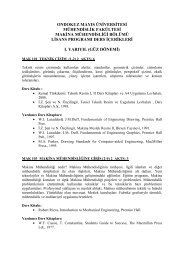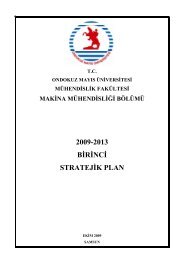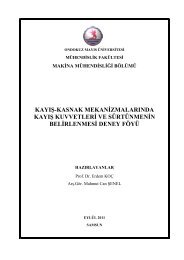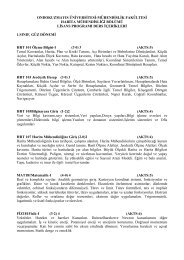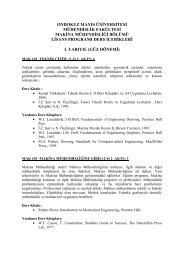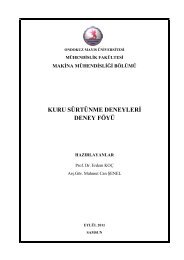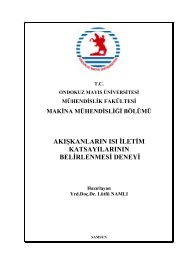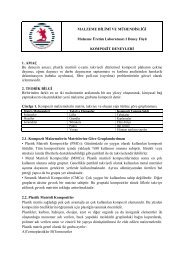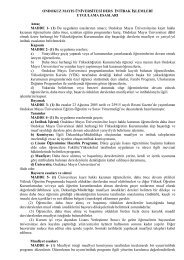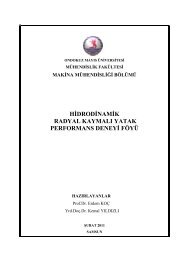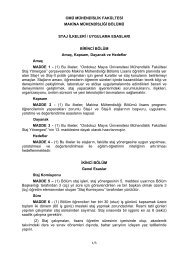ondokuz mayis university faculty of engineering department of ...
ondokuz mayis university faculty of engineering department of ...
ondokuz mayis university faculty of engineering department of ...
Create successful ePaper yourself
Turn your PDF publications into a flip-book with our unique Google optimized e-Paper software.
ONDOKUZ MAYIS UNIVERSITY<br />
FACULTY OF ENGINEERING<br />
DEPARTMENT OF MATERIALS AND ENGINEERING<br />
YEAR I<br />
SEMESTER: FALL<br />
COURSES CONTENTS<br />
MBM 101 Technical Art (1202) (ECTS:5)<br />
Instruments that are used in technical art drawing, standards, geometrical drawings,<br />
projections <strong>of</strong> objects, extraction <strong>of</strong> views, performing measurements, perspective drawing,<br />
completion <strong>of</strong> uncompleted views, surface operation symbols, design geometry.<br />
MBM 109 Introduction To Materials Engineering (2002) (ECTS:5)<br />
What is Materials Science and Engineering? The place <strong>of</strong> Materials Engineering concepts and<br />
Materialds Engineering in our lives and the definition <strong>of</strong> some <strong>engineering</strong> concepts, studying<br />
and listening the course instructors, preparation <strong>of</strong> study notes, library useage, preparation <strong>of</strong><br />
reports, making physical and psychological preparations for passing exams, forming and<br />
administering commisions, speaking to audience, reading an article or a letter, applying a job<br />
and methods for advancing in the pr<strong>of</strong>ession,.historical development <strong>of</strong> materials and their<br />
roles in the industry. Classification <strong>of</strong> materials and their production methods. Surface<br />
techniques that are applied to materials. The physical behavior <strong>of</strong> materials, their mechanical<br />
properties and chemical behavior.<br />
FIZ 105 Physics I (3024) (ECTS:5)<br />
Motion in one dimension, Vectors, Motion in two dimensions, Laws <strong>of</strong> motion, Laws <strong>of</strong><br />
circular motion, Application <strong>of</strong> Newton’s Laws, Work and Kinetical Energy, Potentıal Energy<br />
and Conservation <strong>of</strong> Energy, Linear momentum abd collisions, Kinematics <strong>of</strong> Rotation,<br />
Dynamics <strong>of</strong> Rotation, Angular Mometum, Statics, Harmonical Motion, General<br />
Gravitational Law.<br />
KIM 103 General Chemistry (3003) (ECTS:5)<br />
Matter and Energy, The structure <strong>of</strong> matter, the structure <strong>of</strong> atom, physical and chemical<br />
properties <strong>of</strong> elements, Periodic System, Solid, liquid and gas states <strong>of</strong> matter, chemical<br />
bonds, thermochemical reactions, reaction kinetics, solubility and solubility constant,<br />
Stochiometry, Solids, liquids and changes between states <strong>of</strong> matter, solutions, acids, bases and<br />
their reactions, chemical balance, elektrochemistry, alkali metals, Transition elements,<br />
Organic Chemistry.
MAT 107 Mathematics I (4004) (ECTS:6)<br />
Real and complex numbers, functions and graphics, continuity and limit in functions, differentiation,<br />
differantial and its applications, calculations by the help <strong>of</strong> differentials, in between value, aradeğer,<br />
the average value theorems, numerical solutions <strong>of</strong> equations and Newton formula, Numerical series,<br />
series, force series, Maclaurin and Taylor Series, algebra and transandent functions, logaritmic<br />
functions, hyperbolic functions, inverse functions, undetermined figures in limits, L-Hospital Rule.<br />
YDI 101 Foreign Language I (2002) (ECTS:3)<br />
Tense, conjunctions: The verb To Be, possessive adjectives and pronouns, there is, there are,<br />
some / any / much / many / a lot <strong>of</strong>, countable and uncountable nouns, making polite requests,<br />
comparative and superlative forms <strong>of</strong> adjectives, like / would like.<br />
SEMESTER: SPRING<br />
MBM 102 Computer Aided Drawing (1202) (ECTS:5)<br />
Geometrical drawings, projection rules, extracting the real views from 3-dimensional models<br />
by using AutoCAD computer program, extracting the third view from two main views, 3dimensional<br />
drawing techniques: simple figures, nonlinear surfaces, irregular surfaces, main<br />
principles <strong>of</strong> measurements, main principles <strong>of</strong> cross-sectional elements: complete and half<br />
cross-sections.<br />
MBM 110 Computer Programming (2203) (ECTS:5)<br />
What is the programming language? Computer s<strong>of</strong>tware principles, structural proramming<br />
properties. Machine programming. High level languages. What is programming? Steps in<br />
solving problems, numerical systems, numbers with ten, sixteen and two bases and their<br />
transformations, statements in programming languages, structures, arithmetical statements and<br />
s<strong>of</strong>tware, arithmetical transforming statements, input and output statements, control<br />
statements, alghoritm development, coding in s<strong>of</strong>tware language- starting up, applications.<br />
FIZ 106 Physics II (3024) (ECTS:6)<br />
Charge, matter and electrical field, Gauss Law, electrical potential. Condensator, current and<br />
resistance. Electromotor force; circuits and magnetic field. Ampere law and Faraday<br />
Induction Law. Inductance and magnetic properties <strong>of</strong> matter. Electromagnetic waves.
MBM 104 Physco Chemistry (3024) (ECTS:6)<br />
Solutions and their properties, Chemical Balance: Finding the chemical reaction constant,<br />
Proton Transfer-Acids and Bases; Salt Solutions: Acidic and basic properties <strong>of</strong> ions,<br />
Titrations, Buffer solutions; Energy and thermodynamics in chemical reactions: First law <strong>of</strong><br />
thermodynamics; Electron Transfer-Electrochemistry: Galvanic cells, Electrolysis; Kinetics-<br />
Reaction Speeds: Speed and Concentration, Reaction mechanisms; Main Group Elements I;<br />
Main Group Elements II; d-bloc transition Metals; Nuclear Chemistry: Radioactivity, Nuclear<br />
Energy.<br />
MAT 108 Mathematics II (4004) (ECTS:5)<br />
Volumetric calculation by cylindrical surface method, spring length and the areas <strong>of</strong> round<br />
surfaces, logarithmic and power functions, inverse trigonometric functions, undetermined<br />
figures, L’Hopital rule, hyperbolic and inverse hyperbolic functions, integral techniques,<br />
integral tables and variable changes, partial integration, trigonometric integrals, rational<br />
functions and partial ratios, general integrals, drawing figures and area calculation in polar<br />
coordinates, parametric figure drawing and area calculation, infinite series, vectors, surfaces<br />
and figures in space, cylindrical and spherical coordiantes, continuity and partial<br />
differentiation in multivariable functions, chain rule, directional differentiation, maximum and<br />
minimum problems, area and volume calculations in double integrals.<br />
YDI 102 Foreign Language II (2002) (ECTS:3)<br />
Reported speech, passive voice, comparison, causative sentences, adverbial clauses: Question<br />
forms, infinite <strong>of</strong> purpose, making suggestions , adverbs and adjectives, adjectives ending in<br />
/-ed/ and /-ing/ present, perfect with ‘’ever, never, always, yet, just, since. Adverbial Clauses.<br />
YEAR II<br />
SEMESTER: FALL<br />
MBM 201 Differential Equations (3003) (ECTS:4)<br />
Introduction and basic concepts. First degree differential equations and its applications in<br />
<strong>engineering</strong>. Higher degree lineer differential equations and its applications in <strong>engineering</strong>.<br />
Application <strong>of</strong> second degree lineer differential equations with constant coefficient. Solution<br />
<strong>of</strong> lineer differential equations by exponential series.<br />
MBM 203 Materials Thermodynamics I (3003) (ECTS:4)<br />
System and its environment, properties <strong>of</strong> pure material, tables and diagrams <strong>of</strong> properties, the<br />
state equation, types <strong>of</strong> work and energy. Transfer <strong>of</strong> energy between the system and the<br />
environment, thermodynamic process, reversible and non-reversible processes. The First law<br />
<strong>of</strong> Thermodynamics for open and closed systems, Entropy and the second law <strong>of</strong><br />
thermodynamics, the second law <strong>of</strong> thermodynamics for <strong>engineering</strong> systems
MBM 205 Materials Science I (2203) (ECTS:5)<br />
Introduction to Materials Science and Engineering. Classification <strong>of</strong> <strong>engineering</strong> materials,<br />
Experimental characterization techniques <strong>of</strong> Materials. Non-destructive characterization<br />
techniques <strong>of</strong> materials. Atomic structure and chemical bonds. Crystal strcuture and<br />
geometry, Liquidification and evaporation <strong>of</strong> metals. Crystal defects. Corrosion and its<br />
control. Types <strong>of</strong> Phase Diagrams, iron-carbon phase diagrams. Materials systems: Iron-based<br />
materials, non-iron based materials, Polymers, Ceramics, Composites.<br />
MBM 207 Statics and Strength (3003) (ECTS:4)<br />
Introductıon to forces and vectors: Vector calculations. Equilibrium <strong>of</strong> solids. Equilibrium <strong>of</strong><br />
equi-planar systems. Equilibrium <strong>of</strong> three-dimensional systems.. Resultant vector <strong>of</strong> force<br />
system. Moment, Moment <strong>of</strong> pair-force. Resultant force and pair-force moment system:<br />
Equilibrium <strong>of</strong> solid objects: Equivalent force systems in solid objects. Structural analysis:<br />
Member-beam systems, frames and machines. Internal forces: İnternal forces in structural<br />
elements. Friction. Centroid and center <strong>of</strong> gravity. Momentum <strong>of</strong> inertia. Virtual work<br />
method. Introduction to strength, basic definitions internal force, external force, stress, safety<br />
stress and safety coefficient,thermic stress, thermic stress in composite rods, the effect <strong>of</strong><br />
density to strain, rods with equal strength, stress in pressurized vessels, one and two axes<br />
stress transformations, Mohr’s cycle, basic stress, Hooke’s Law, normal and slip stress in<br />
vertical loaded beams, normal and slip stress in variable pr<strong>of</strong>ile cross sections, the importance<br />
<strong>of</strong> slip stress in determining <strong>of</strong> cross section, prime stress in bending, torsion, column theory,<br />
thick and thin columns, states <strong>of</strong> compound strength.<br />
MBM 209 Materials and Energy (3003) (ECTS:4)<br />
Stoichiometric calculations; Mass balance calculations; Heat balance; Types <strong>of</strong> reactions;<br />
Application <strong>of</strong> thermochemical principles; Mass and heat balance applications on selected<br />
processes.<br />
MBM 211 Pr<strong>of</strong>essional English (3003) (ECTS:4)<br />
Definition <strong>of</strong> frequently used terms and expressions in Material Engineering. Translation <strong>of</strong><br />
these terms and expressions and translation <strong>of</strong> some papers chosen from literature to Turkish.<br />
Providing <strong>of</strong> the presentation <strong>of</strong> technical English sources including books, papers, CD, etc.<br />
for Material Science and Engineering with the attendance <strong>of</strong> students.<br />
TDI 201 Turkish Language I (2002) (ECTS:2)<br />
Elements <strong>of</strong> sentence, analysis and application <strong>of</strong> sentences, listening and understanding <strong>of</strong><br />
literature and technical literature, understanding <strong>of</strong> writing ideas, incoherency and its fixing,<br />
rules <strong>of</strong> writing <strong>of</strong> scientific articles (report, article, paper, etc.), improvement <strong>of</strong> speaking and<br />
writing skills <strong>of</strong> students by sample <strong>of</strong> selected articles from Turkish and world literature and<br />
history and rhetoric applications <strong>of</strong> them.
SEMESTER: FALL<br />
MBM 202 Linear Algebra and Numerical Methods (3003) (ECTS:5)<br />
Vector spaces, Vector sub-spaces, linear relationship, base and dimension, bases for 4 basic<br />
sub-spaces, Gram-Schmidt method, linear transformations, zero spaces <strong>of</strong> linear<br />
transformations, Matrices and determinants, inverse matrices, Symmetric ve pozitive defined<br />
matrices, linear vectors, base transformation, Projections, Matrix and vector norms.<br />
MBM 204 Materials Thermodynamics II (3003) (ECTS:6)<br />
Ideal gases and compounds; Third Law <strong>of</strong> Thermodynamics; Ellingham Diyagrams.<br />
Properties <strong>of</strong> integral; Partial properties; Chemical Potential; Gibbs-Duhem Equation;<br />
Activity; Quasi-chemical model; İdeal Solutions; Real Solutions; Raoult’s Law; Henry’s Law;<br />
Alfa Function; Clausius-Clapeyron Equation; Reference and standart states;interaction<br />
coefficients and parameters.<br />
MBM 206 Materials Characterization Techniques (3003) (ECTS:6)<br />
Importance <strong>of</strong> characterisation; Classification <strong>of</strong> characterization techniques; Microscobik<br />
characterizasyon techniques; History <strong>of</strong> microscobe; Sample preparation; Ligth microscopy;<br />
Comparison <strong>of</strong> ligth and electrons; Why electron microscope;Scanning electron microscopy;<br />
Transmission electron microscopy; Chemical analyses in electron microscopy; Other<br />
microscopes; Non microscobic techniqes, Difraction; X-Ray diffraction; Thermal analyses<br />
devices; Other characterization techniques.<br />
MBM 208 Phase Diagrams (3003) (ECTS:5)<br />
Thermodynamics and phase equilibrium; Phase diagrams <strong>of</strong> one-component systems: Phase<br />
diagrams <strong>of</strong> two- component systems; Solidification <strong>of</strong> liquids in two-component equilibrium<br />
diagrams, Solid solutions, Congruently and incongruently melted intermetalic compounds,<br />
Non-mixing liquids; Drawing <strong>of</strong> phase equlibrium diagrams: Experimental methods,<br />
Thermodynamical calculation methods; Phase diagrams <strong>of</strong> three-component systems:<br />
Analysis <strong>of</strong> composition, Solidification <strong>of</strong> liquids in three-component equilibrium diagram,<br />
Intermetalic compounds in three-component systems; Phase diagrams <strong>of</strong> multi-component<br />
systems.
MBM 210 Materials Science II (2203) (ECTS:5)<br />
Mechanical behavior <strong>of</strong> materials: tensile test, stress-strain correlations, brittle behavior <strong>of</strong><br />
materials, ductile behavior <strong>of</strong> materials, slip, hardness. Physical properties <strong>of</strong> materials:<br />
density, water sorption, void ratio, permeability, capilar water sorption. Internal structures <strong>of</strong><br />
materials: atomic structure, ionic bond, covalent bond, metalic bond, Van der waals bonds,<br />
bond energy, classification <strong>of</strong> materials. Crystal structure: directions and planes, metals,<br />
ceramics. Crystal defects : point defects, plane defects. Amorph structure: glass, liquid, gas<br />
and phases. Solid solutions, diffusion. Strengtened mechanisms: cold hardening, hot<br />
hardening, annealing, alloying, eutectic alloys, heat treatment, tempering, ductility, ,<br />
brittlement and fatigue. Materials mass equations.<br />
TDI 202 Turkish Language II (2002) (ECTS:3)<br />
What is language: Origins <strong>of</strong> language, Language-culture-nation relationships; Linguistic<br />
Reform: Turkish Language Association and its activities; World languages: Family <strong>of</strong><br />
language, The importance <strong>of</strong> Turkish in other languages; The properties <strong>of</strong> Turkey’s Turkish:<br />
sound properties, the property <strong>of</strong> sentence; writing rules; Punctuation marks; being on<br />
correspondence: CV, application forms, business letters, Telegraph; Properties <strong>of</strong> speaking:<br />
Rules in speaking, Effective speaking; Listening: Rules in listening; Reading: Critical<br />
reading; Types <strong>of</strong> literature: story, novel, paper, essay, poem, drama.<br />
YEAR III<br />
SEMESTER: FALL<br />
MBM 301 Mechanical Behavior <strong>of</strong> Materials (3003) (ECTS:4)<br />
Atomic bond and crystal structure; Elastic behavior <strong>of</strong> crystal structures; Tensors; Basics <strong>of</strong><br />
fracture mechanisms; Fracture strength <strong>of</strong> materials; Plastic deformation <strong>of</strong> crystal structures;<br />
Viscosity and visco-elasticity; Creep; Fatigue; Mechanic behavior and quantitative<br />
techniques; Improvement <strong>of</strong> strength and toughness in materials; Thermal behavior <strong>of</strong><br />
materials; Analysis <strong>of</strong> mechanical defects; Design <strong>of</strong> <strong>engineering</strong> and strength.<br />
MBM 303 Metalic Materials (3003) (ECTS:4)<br />
Fe-Fe3C Equilibrium Phase Diyagram; Heat treatment <strong>of</strong> steels; Time-Temperature-<br />
Transformation Diagrams; Alloys added steels; Stainless steels; Standarts <strong>of</strong> ferrous<br />
materials; D.I.N. Standarts; AISI/SAE Standarts; White, grey, tempered and nodular cast<br />
irons; Nonferrous metals and its alloys; Copper and its alloys; Aluminium and its alloys;<br />
Nickel and its alloys; Titanium and its alloys.
MBM 305 Transport Events (3003) (ECTS:4)<br />
Momentum transfer: Viscosity and momentum transfer mechanisms, Velocity distribution in<br />
laminar , Continuum mechanics, Transport equations; Energy Transfer: Thermal conductivity<br />
and energy transfer mechanisms, Temperature distribution in solids and laminar flow.,<br />
Variation equations in non-isothermal systems.; Mass Transfer: Diffusion and mass transfer<br />
mechanisms, Concentration distribution in solids and laminar flow, Variation equations in<br />
multi-component systems.<br />
MBM 307 Polymeric Materials (3003) (ECTS:4)<br />
Introduction to large molecule science; Polymerization; In stage reaction polimerisation<br />
(condensation), Radical chain (Addition) Polymerisation, Ionic and coordination chain<br />
Polymerization, Co-Polymerisation, Requirements for polymerisation and polymer reactions,<br />
Characterization; Polymer solutions, Molecular mass and dimension measurement, Analysis<br />
and test <strong>of</strong> polymers, Structure and property; Order and morphology in crystalline polymers,<br />
Mechanical properties and reology <strong>of</strong> polymers, Physical properties and structures <strong>of</strong><br />
polymers, Properties <strong>of</strong> commercial polymers; Hydrocarbon plastics and elastomers, Other<br />
carbon-chain polymers, Thermoplastics with hetero-chains, Hardened resins after heating,<br />
Product technologies <strong>of</strong> polymer, plastic, fiber and elastomer.<br />
MBM 309 Materials Production Laboratory I (2023) (ECTS:5)<br />
Applications related to Materials Science and Engineering in laboratory.<br />
MBM 311 Statistical Methods in Engineering (3003) (ECTS:3)<br />
Basic concepts related to probability and statistics, random variable and random event,<br />
concept <strong>of</strong> probability, distribution <strong>of</strong> random variables and parameters, frequency analysis<br />
and parameter estimation, probability distribution functions, sampling distributions,<br />
hypothesis tests, non-parametric tests, regression and correlation analysis, variance analysis.<br />
ATI 301 History <strong>of</strong> Atatürk Principles and Revolutions I (2002) (ECTS:3)<br />
Turkish reforms and reform movements: Character and targets <strong>of</strong> reforms. Political<br />
reforms:Building <strong>of</strong> Public Party, İzmir assasination, Liberty Court, Revolution <strong>of</strong> educationculture:,<br />
The modernization <strong>of</strong> new Turkish alphabet, Establishment <strong>of</strong> Turkish language<br />
association for regulating the Turkish language, Establishment <strong>of</strong> Turkish historical society<br />
for research on history. Social reforms: Law related to religious convents and dervish lodges,<br />
Law on family names, The international time and calendar system and the system <strong>of</strong><br />
measures. Political reforms involving other countries: Lozan and Montrö pacts, Turkey<br />
Europe relationships. The fundamental principles <strong>of</strong> Atatürk’s reform: Republicanism,<br />
Nationalism,, Populism, State Socialism, Secularism, Reform.
SEMESTER: SPRING<br />
MBM 304 Ceramic Materials (3003) (ECTS:4)<br />
Introduction to ceramic materials. Types <strong>of</strong> ceramics. Traditional ceramics, advanced<br />
ceramics, properties <strong>of</strong> refracters and applications. The principles <strong>of</strong> crystal structures <strong>of</strong><br />
ceramics. Properties and types <strong>of</strong> natural and artificial raw materials. Physical, chemical and<br />
mineralogical properties <strong>of</strong> raw materials and the method <strong>of</strong> analysis <strong>of</strong> them. Raw material<br />
processes. Artificial ceramic powders. Ceramics shaping principles and technologies.<br />
Properties and production <strong>of</strong> ceramic glaze. Mass and glaze formulations. Priniples <strong>of</strong> drying<br />
<strong>of</strong> ceramic powders. Sintering. Mechanisms <strong>of</strong> powder sintering and firing methods. Ceramic<br />
furnaces. Quality control methods in ceramics. National and international standarts.<br />
MBM 306 Raw Materials and Basic Processes (3003) (ECTS:4)<br />
Ores concentration processes; Ready to use recyclable and half-produced raw materials with<br />
added metalurgical processes; Process flow chart and the detailed physical and chemical<br />
seperation methods to concentrate the raw materials; Application and principles <strong>of</strong> mineral<br />
process; Pre-processes; Drying, calcination, roasting and agglomeration.<br />
MBM 308 Composite Materials (3003) (ECTS:4)<br />
Definition and classification <strong>of</strong> composite materials; Particle reinforced composites,<br />
Laminated composites, Micro-mechanics <strong>of</strong> composites, E-modul as a type <strong>of</strong> fiber and<br />
design <strong>of</strong> fiber, providing <strong>of</strong> equations <strong>of</strong> tensile strength and Poisson’s ratio, Minimum<br />
volume ratio, determining <strong>of</strong> max volume as a design factors, determining <strong>of</strong> stress equations<br />
<strong>of</strong> continuous and random distributed composites, Design factors, Plastic, Ceramic, and metal<br />
matrix composites, production methods <strong>of</strong> plastic matrix composites, Fiber Materials,<br />
standarts and experiments on composites.<br />
MBM 302 Materials Production Laboratory II (2023) (ECTS:6)<br />
Heat treatments and its laboratory work, composite processes and its laboratory, powder and<br />
ceramic process laboratory, plastic shaping laboratory, corrosion laboratory, casting<br />
laboratory, machining laboratory, analysis by SEM, chemical analysis, welding.<br />
ATI 302 History <strong>of</strong> Atatürk Principles and Revolutions II (2002) (ECTS:3)<br />
Turkish reforms and reform movements: Character and targets <strong>of</strong> reforms. Political<br />
reforms:Building <strong>of</strong> Public Party, İzmir assasination, Liberty Court, Revolution <strong>of</strong> educationculture:,<br />
The modernization <strong>of</strong> new Turkish alphabet, Establishment <strong>of</strong> Turkish language<br />
association for regulating the Turkish language, Establishment <strong>of</strong> Turkish historical society<br />
for research on history. Social reforms: Law related to religious convents and dervish lodges,<br />
Law on family names, The international time and calendar system and the system <strong>of</strong><br />
measures. Political reforms involving other countries: Lozan and Montrö pacts, Turkey<br />
Europe relationships. The fundamental principles <strong>of</strong> Atatürk’s reform: Republicanism,<br />
Nationalism,, Populism, State Socialism, Secularism, Reform.
YEAR IV<br />
SEMESTER: FALL<br />
MBM 401 Materials Selection and Design (3204) (ECTS:9)<br />
Vector mechanics; Mechanics <strong>of</strong> fixed matter; Beams; Moment <strong>of</strong> inertia; Materials selection<br />
and design: Design; Type <strong>of</strong> design, Technical systems, Design process, Data <strong>of</strong> materials<br />
properties and design instrument, Engineering materials; Metals, Ceramics, Polimers,<br />
Composites, Materials selection graphics, Selection <strong>of</strong> materials and figure, Process selection<br />
graphs; Term project.<br />
MBM 403 Quality Control (3003) (ECTS:5)<br />
Quality development and quality control: Qulity development term, Probability and statistics<br />
in quality control, Quality control in total quality management; Statistical methods in quality<br />
control: variability and measurement, important noncontinuous and continuous distributions,<br />
Sampling distribution, Estimation <strong>of</strong> parameters and hypothesis tests; Statistical process<br />
controls: İSK philosopy and methods, Application, Control graphics <strong>of</strong> quantitative and<br />
qualitative dimensions, Other statistical process control techniques, Process analyses,<br />
Acceptance sampling and sampling plans, various qualitiy control standarts<br />
MBM 405 Engineering Economics (2002) (ECTS:3)<br />
Basic definiton <strong>of</strong> <strong>engineering</strong> economics; basic economic terms, cost, interest and interest<br />
formulations, money time formulations. Micro-economy: Markets, supply and demand terms,<br />
flexibility, market equlibrium, cost analyses, Macro-economy: gross national product growth,<br />
national income, economic growth, inflation, unemployment, money and money supply.<br />
Application <strong>of</strong> <strong>engineering</strong> economics; application <strong>of</strong> money-time formulations, comparison<br />
<strong>of</strong> alternative solution, currency flow, inflation and price alteration, replacement investment.<br />
Additional topics in <strong>engineering</strong> economics; adjudication under risk, application <strong>of</strong> decision<br />
tree, impact diagrams, adjudication by expected value, adjudication under uncertainty,<br />
strategic evaluation techniques.<br />
MBM 407 Special Topics in Materials Science and Engineering I (0201) (ECTS:4)<br />
Special Topics in Materials Science and Engineering has been selected and investigated.
SEMESTER: SPRING<br />
MBM 400 Graduation Study (2404) (ECTS:9)<br />
A special topic has been selected in related with Materials Engineering. A problem which is<br />
related special topic has been determined and solved theoretically and practically. All results<br />
has been reported and presented by oral and written<br />
MBM 404 Work Law (2002) (ECTS:3)<br />
History <strong>of</strong> work law, Sources and basic concept; Appication area <strong>of</strong> work law: employee,<br />
employeer, work place, service agreement: Resignation and the results <strong>of</strong> resignation,<br />
discharge obligation; Organization and protection <strong>of</strong> work individually, General groups;<br />
Worker health and job security; Evaluation <strong>of</strong> work as a time <strong>of</strong> duration; overtime work and<br />
shift; preparing, finishing and cleaning.<br />
MBM 406 Nanomaterials and Nanotechnology (3003) (ECTS:5)<br />
Physical dimensionality, Future <strong>of</strong> the Nanotechnology and Nanoscience, Nano and micro<br />
<strong>engineering</strong>, Molecular and Nanoelectronic : concept and design, Chemical synthesis and<br />
production <strong>of</strong> nanostructured powder and films, Thermal spray process <strong>of</strong> nanocrystalline<br />
materials, Production <strong>of</strong> nanostructered materials and composite by solid state method,<br />
Densification methods <strong>of</strong> nanocrystalline powder, Electrodeposited nanocrystalline materials,<br />
Diffusion behaviour <strong>of</strong> nanocrystalline materials, Mechanical properties <strong>of</strong> nanocrytalline<br />
metals, Formation,stability and mechanical properties <strong>of</strong> nanocrystalline materials,<br />
Nanostructured electronic and optoelectronic materials,Carbon nanotubes , Nano-bio<br />
technology.<br />
MBM 408 Special Topics in Materials Science and Engineering II (0201) (ECTS:4)<br />
Special Topics in Materials Science and Engineering has been selected and researched<br />
ECTS: European Credit Transfer and Accumulation System



